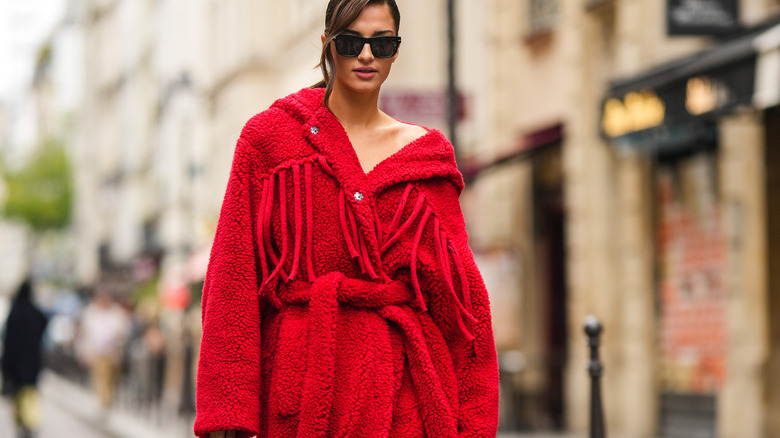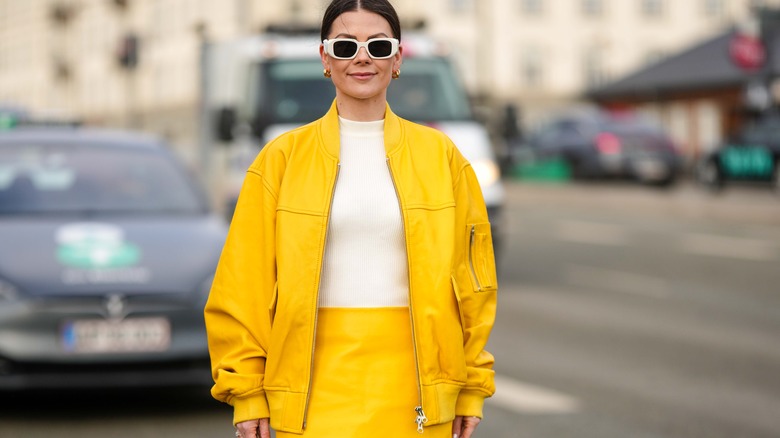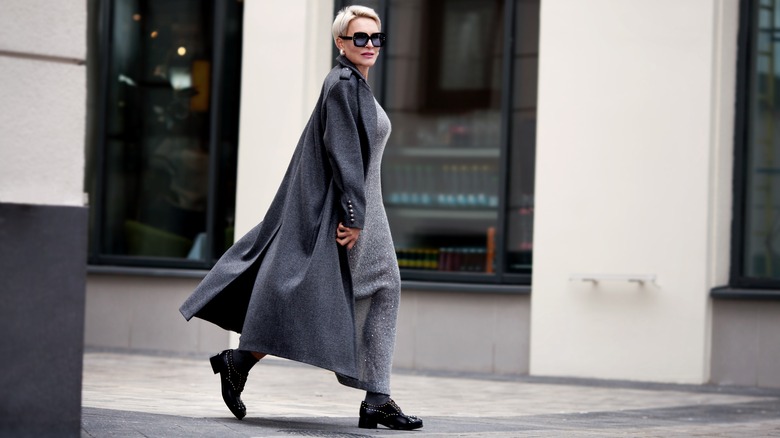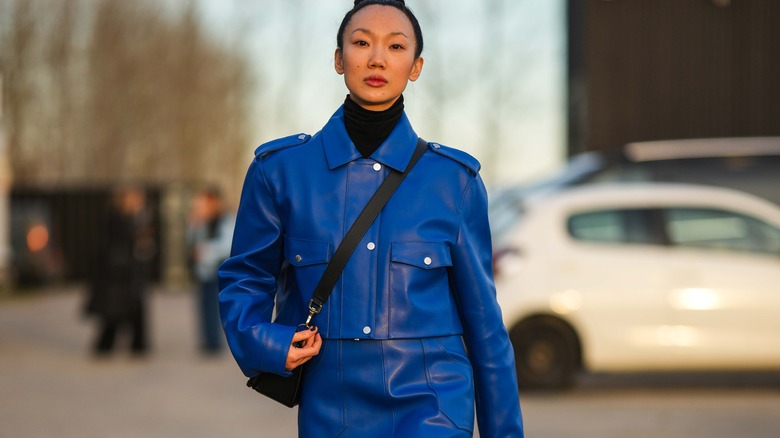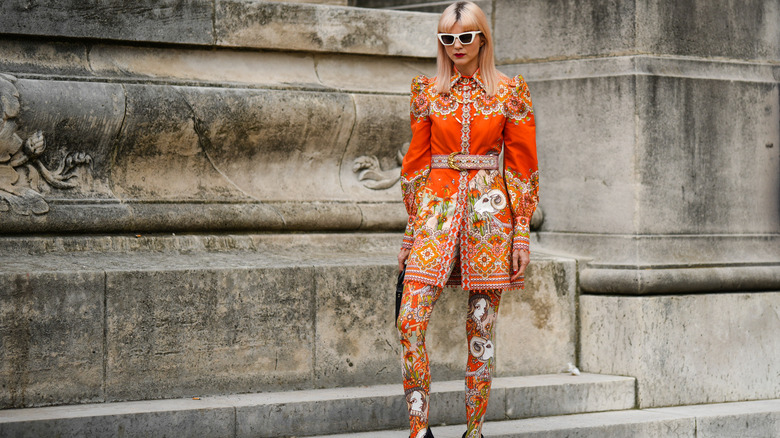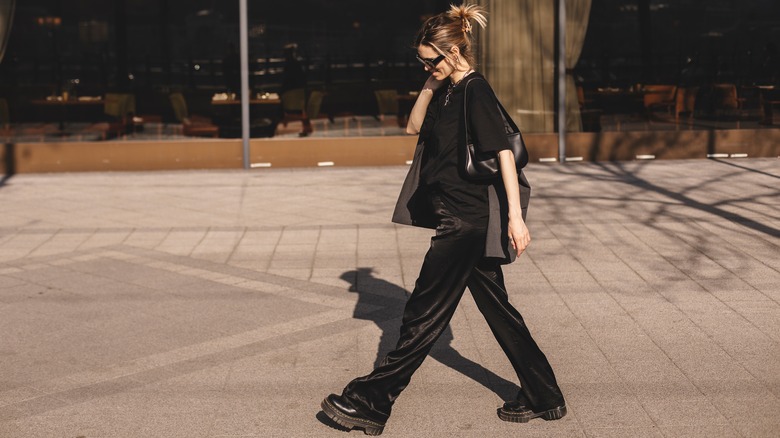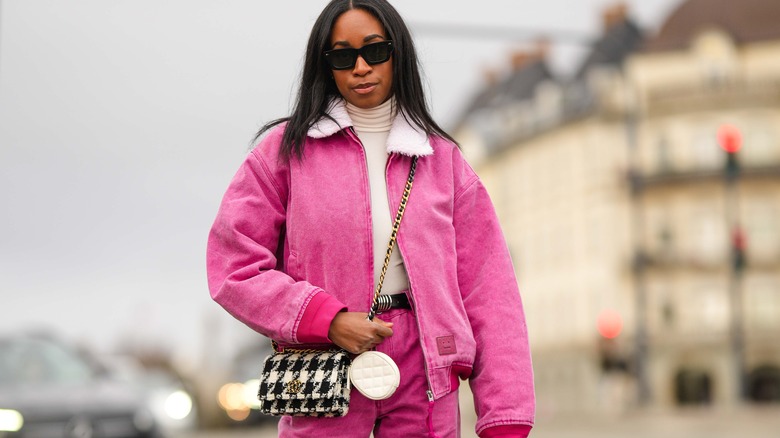This Is Your Perfect Color, According To Your Enneagram Number
The Enneagram is a set of nine unique personality types. Each number on the Enneagram denotes a personality type named the Reformer, the Helper, the Achiever, the Individualist, the Investigator, the Loyalist, the Enthusiast, the Challenger, and the Peacemaker. Each personality type is a sequence of behaviors, attitudes, defenses, and motivations (via The Enneagram Institute). The nine Levels of Development form the personality type and are crucial in accounting for the variety of people who belong to the same personality type and explain how people can change for better or worse.
It's common for you to feel defined by more than one Enneagram type, however, your Enneagram number is your dominant personality type. Your dominant or basic type is the type that stands out the most to you. In other words, the type of quality that is the closest to your personality is your dominant type. According to the Enneagram Institute, "no one is a pure personality type: everyone is a unique mixture of [their] basic type and usually one of the two types adjacent to it on the circumference of the Enneagram." We gave it a fun twist by analyzing the Enneagram types and assigning a unique color to each one.
Type One: The Reformer
The Reformer is "principled, purposeful, self-controlled, and perfectionistic" (via The Enneagram Institute). Reformers are idealists and have a fear of being corrupt so they strive to be good. They value integrity and dream to be beyond criticism. Type Ones are those who don't hesitate to leave their easy, comfortable lives to pursue a higher calling. Type Ones are "activists who are searching for an acceptable rationale for what they feel they must do."
At their best, they are the wise, go-to people. They're aware of the right step to be taken at any given time and are inspiring personalities. At their worst, they have a tendency to develop obsessive-compulsive disorders and slide into depression (via The Enneagram Institute). Type Ones are rational beings who value practical action. To achieve their best selves, type Ones have to learn the art of forgiveness. They need to let go of their irritation toward other people's wrongdoings that have nothing to do with themselves. They also need to be patient and stop holding themselves to unattainable standards. Type Ones can greatly benefit from journaling, group therapy sessions, and other activities that promote getting in touch with one's emotions.
White is their color. White represents purity, integrity, and simplicity (via Adobe) — values the Reformer appreciates the most.
Type Two: The Helper
The Helper is "generous, demonstrative, people-pleasing, and possessive" (via The Enneagram Institute). Type Twos are empathetic beings who are friendly and generous. Type Twos desire to feel loved and are fearful of ever feeling unwanted or unloved. They have a constant need to be appreciated and validated. They're called Helpers because they love helping others and spend a considerable time presenting themselves as helpful. At their best, type Twos are deeply altruistic, extremely unselfish, and the living embodiments of humility. At their worst, their need for constant validation can make them resentful and angry toward their environment. In this stage, Twos "present a false image of being completely generous and unselfish and of not wanting any kind of pay-off for themselves, when in fact, they can have enormous expectations and unacknowledged emotional needs" (via The Enneagram Institute).
At this level, type Twos can get manipulative and gaslight people they love into submission by reminding them of what they owe them. To achieve their best selves, type Twos need to remember not to deliberately invite attention to themselves and their good deeds. They also have to do some self-introspection and analyze the motivation behind wanting to help someone.
Red is their color. Red represents love (via Color Meanings), something that type Twos chase their entire lives. Red promotes self-assurance, a quality that type Twos need to inculcate to be their best selves. Red is also the color of caution, manipulation, and domination.
Type Three: The Achiever
The Achiever is "adaptable, excelling, driven, and image-conscious" (via The Enneagram Institute). Type Threes are energetic, competent beings with high ambitions. They're extremely driven toward advancing and have a constant need to climb the social ladder. They tend to work long hours with an unhealthy competitive mindset. They're motivated toward impressing others and desire to be seen as valuable and worthwhile. Their biggest fear is being worthless.
They're named such because, at healthy Levels of Development, they have the ability to achieve greatness and be great role models. Their most admirable quality is their belief in themselves and their talents. They constantly strive to achieve their personal definition of success. Because of this, they might lose themselves and their true passions and can be a victim of self-deception. Threes can "become dependent on receiving attention from others and in pursuing the values that others reward, they gradually lose touch with themselves" (via The Enneagram Institute). At their best, type Threes are self-motivated, driven, and benevolent. They're a delight to know and are real role models. At their worst, they're narcissists and motivated to destroy other people's lives because it reminds them of their own shortcomings.
Yellow is their color. Yellow embodies the energy and enthusiasm (via George Mason University) by which Achievers lead their lives.
Type Four: The Individualist
The Individualist is "expressive, dramatic, self-absorbed, and temperamental" (via The Enneagram Institute). Type Fours are emotionally available, creative, self-conscious folks who are often perceived as moody. Their deepest desire is to find themselves and their true purpose in life. Lacking an identity or being of no significance is their deepest fear. Type Fours are motivated to express themselves and deeply value their individuality. They struggle with maintaining a balance to their melancholy-driven self-indulgence. Type Fours find themselves to be unique from the rest of their peers and, in turn, believe that nobody will be able to understand or love them for who they are.
Type Fours "often see themselves as uniquely talented, possessing special, one-of-a-kind gifts, but also as uniquely disadvantaged or flawed" (via The Enneagram Institute). They are the "romantics" of the Enneagram. They pine for a fairytale lover to come and appreciate their true self but spend years hiding from the outside world. Type Fours might go through multiple identity crises in their lifetime and might change their personal style frequently. Even after this, they still feel like they haven't really found their real self. This results in a dip in self-confidence and leads to chronic self-esteem issues. At their best, they're self-renewing and creative. At their worst, type Fours feel hopeless and turn self-destructive.
Gray is their color. Gray implies "a dark state of mind, a colorless and monotonous life" (via WebMD)— which can reflect type Fours' "feeling gray" mood.
Type Five: The Investigator
The Investigator is "perceptive, innovative, secretive, and isolated" (via The Enneagram Institute). Type Fives are independent beings who are preoccupied with their thoughts. They're concentrated on innovating complex theorems and tools. Type Fives are those who we usually call "ahead of their time." They desire to be capable and competent problem-solver. Their deepest fear is incapability and helplessness. These curious beings are motivated to understand everything about their surroundings and are driven by a thirst for knowledge. They're hyper-focused on understanding why things are the way they are.
The reasoning behind this tireless journey in pursuit of knowledge is the deep-seated insecurity about their inability to function in the world. Type Fives feel they're not as equipped as their peers when dealing with the realities of the world. They tend to stay within the boundaries of their own psyche which they understand better than the real world. This pursuit of knowledge is not fueled by a need for attention or validation. At their best, they're highly skilled experts in their chosen fields. At this stage, they have the ability to change the world by making pioneering discoveries and ground-breaking innovations. At their worst, their fear of the real world can drive them to deliria.
Green is their color. Green embodies Fives at both their best and worst. Green represents innovation, growth, concentration, and prosperity (via Colors Explained).
Type Six: The Loyalist
The Loyalist is "engaging, responsible, anxious, and suspicious" (via The Enneagram Institute). Type Six is a reliable and trustworthy friend who wants to settle down as soon as possible. Their biggest desire is to be secure and committed. They fear being without support or guidance. They're motivated to receive reassurance from those around them. Type Sixes are the most loyal of the Enneagram types. To have a type Six friend is truly a blessing. Their unwavering loyalty also extends toward their personal ideals and value systems that go against the status quo — making them revolutionaries.
At their best, type Sixes are trusting of the people around them and are great leaders who teach by example. At this stage, they have the ability to invoke trust with others and build strong emotional bonds. At their worst, they're constantly worried they've ruined their security. They feel defenseless and end up constantly seeking out authority. They feel persecuted, act out of fear, and have violent tendencies. Their major problem is that they "try to build safety in the environment without resolving their own emotional insecurities" (via The Enneagram Institute). Type Sixes are advised to sit with their stressful and anxious thoughts and figure out what makes them overreact.
Blue is their color. It represents stability, security, and reliability (via Verywell Mind). Blue is also the color of calmness and relaxation, the qualities type Sixes have to inculcate to be their best selves.
Type Seven: The Enthusiast
The Enthusiast is "spontaneous, versatile, acquisitive, and scattered" (via The Enneagram Institute). Type Sevens are generally optimistic beings bubbling with enthusiasm. They're adventurous and constantly seek new, exciting experiences, but are also perpetually distracted. Their biggest desire is very simple — to have all their needs met. They fear being deprived of their needs and of being in pain. They enjoy their freedom and prioritize their happiness. They don't like missing out on adventures and like to be busy. They approach the world in a child-like way and are often curious about shiny things that catch their eyes. While type Sevens don't come off as your average intellect, they're often well-read and fast learners.
Since their minds don't stay focused for long, they're very good at brainstorming. They're proverbial "jack of all trades, master of none." This is also detrimental because they're often unable to choose a career path. At their best, they're multi-talented, enthusiastic achievers gushing with energy. At this level, they're living embodiments of gratitude and contentment. At their worst, they're burnt out from trying out every exciting thing that comes their way. They become greedy and discontent, act out of impulse, and risk losing themselves.
Orange is their color. It represents excitement, enthusiasm, and energy (via Verywell Mind). Like type Sevens, orange is highly stimulating, playful, and friendly. It's attention-grabbing but also a warning sign to stop and slow down before moving forward.
Type Eight: The Challenger
The Challenger is "self-confident, decisive, willful, and confrontational" (via The Enneagram Institute). Type Eights are aspiring heroes. They're resourceful and decisive but can become ego-centric and controlling. Their basic desire in life is to protect themselves and be in control of their own destiny. Consequentially, their biggest fear is losing control or being controlled by others in any form — socially, financially, or psychologically. They're self-reliant and motivated to be important people and in control of their surroundings.
Type Eights are charismatic beings with exceptional willpower and are keen on leaving their marks on the world. They have great physical endurance and a high tolerance for physical power but are extremely afraid of emotional pain. They fear vulnerability and cover it with the tough outer façade of always being in control. Type Eights are industrious to the point that they become emotionally unavailable to their loved ones, creating a sense of dissatisfaction in their interpersonal relations. At their best, they're confident with a "can do" attitude and are driven by a passion for greatness. At this level, they may achieve true greatness. At their worst, they're hard-hearted dictators or outlaws.
Black is their color. Black embodies the basic traits of type Eight. It represents strength, authority, strong will, confidence, and power (via Verywell Mind).
Type Nine: The Peacemaker
The Peacemaker is "receptive, reassuring, agreeable, and complacent" (via The Enneagram Institute). Type Nines are gentle, trusting creatures who value peace more than anything. They hate conflict and stubbornly maintain peace by twisting facts and minimizing the gravity of situations. Their deepest desire is to achieve peace of mind and fear loss and separation. They're motivated by avoiding conflicts and tensions, preserving things as is, and resisting change. They want constant harmony in their environment and hate disturbances. They're constantly striving toward achieving peace, both internally and externally. They're the "spiritual seekers" of the Enneagram.
Peacemakers have the dominant qualities of all the other Enneagram types but lack of strong sense of who they truly are. Type Nines are the embodiments of "the universal temptation to ignore the disturbing aspects of life and to seek some degree of peace and comfort by 'numbing out'" (via The Enneagram Institute). Type Nines tend to run away from life when it gets difficult. At their best, they're fulfilled and at one with themselves. At their worst, they're shells of who they were meant to be. At this level, they're at risk of being severely disoriented.
Pink is their color. Pink represents peace, tranquility, nurture, and compassion (via Verywell Mind). It also represents the immaturity of type Nines. Pink represents childhood, the kind of non-complexity a type Nine desires to achieve in life.


